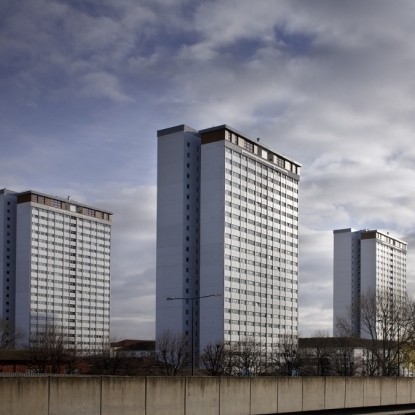
At a special event held at the London School of Economics and Political Science (LSE), LSE Housing and Communities, in partnership with ROCKWOOL, launched High Rise Hope Revisited, a new report examining the social implications of whole building energy efficiency refurbishments in residential tower blocks.
Based on research conducted at the Edward Woods estate in Shepherds Bush, London, the report finds that upgrading work carried out across 754 flats in three 23-storey tower blocks has enhanced the quality of life and living conditions for residents, with aesthetic improvements instilling a sense of pride within the community.
The Edwards Woods estate scheme was led and managed by the Hammersmith and Fulham Council, who commissioned Energy Conscious Design (ECD) Architects and the building contractors Breyer for the project which began in 2011. Ambitious and complex in nature, it has primarily involved remedial work on the concrete building structure, external cladding of the blocks with ROCKWOOL’s External Wall Insulation System and the installation of solar panels to provide 82,000 kWh of electricity annually for lifts and communal lighting. The scheme was used as a model case study for how the Green Deal and Community Energy Saving Partnership (CESP) ‘whole building’ approach would work in high-rise, socially rented estates.
High Rise Hope Revisited is the second part of the LSE’s study at the Edward Woods estate. In 2012, an initial report, High Rise Hope, interviewed residents during the renovation works. Following this research, LSE returned to the estate when all the upgrading work was complete to highlight lessons learned and assess the social and community impact of transforming a 1960s local authority housing estate into a landmark, high rise model of social housing.
Among the most significant lessons learned from the project was the importance of communication with residents. High Rise Hope Revisited recommends regular community updates are necessary to ensure tenants feel part and informed of improvement works. In addition to initial consultations, the report suggests more ongoing support helps to improve wider understanding of the objectives of regeneration, and to explain any delays that occur. The residents of Edward Woods cited better management of the works as their overriding suggestion for improvement.
LSE’s key findings in the second report, High Rise Hope Revisited, demonstrate that, “Overall, residents value living on the estate. Residents on the Edward Woods estate like their homes, they find their flats comfortable and have a generally high quality of life.” The research also states that, “residents are positive about the estate and their homes and generally feel safe living there.” In fact, “78% now describe their quality of life in their home as good or excellent, compared with 68% in 2011, showing a marked improvement,” and “people are generally proud to live on the estate, with many saying this had improved since the regeneration. Residents overwhelmingly say they enjoy living there.”
“Edward Woods has a fascinating history because it is a large, concrete, high-rise, council-owned estate, housing a very low income community in 23 storey tower blocks and maisonettes in a very busy part of West London,” says Professor Anne Power, LSE Housing and Communities. “It is popular, well managed, attractive and fully occupied. It shows that with careful on-site management, high-rise estates can work, if they are also made energy efficient. This is crucial so that residents can pay their rent, meet basic costs and escape fuel poverty.”
Darren Snaith, Director of Refurbishment and Regeneration at ROCKWOOL, comments, “High Rise Hope Revisited shows that whilst this type of refurbishment scheme can help alleviate fuel poverty, the transformation of the visual appearance of Edward Woods at both estate and wider neighbourhood scale has improved the sense of well-being of residents, making the area a more attractive environment to live.”
He adds, “We are delighted to have partnered with the LSE on this important research project which will provide invaluable lessons for other local authorities keen to implement large scale energy efficiency schemes. In fact, the lessons learned have already been put to work in an upcoming energy efficiency project, the refurbishment of Wilmcote House by Portsmouth City Council. It shows that fuel poverty can be alleviated and marked improvements to the quality of high rise living achieved, when accompanied by proper support and advice for tenants.”










